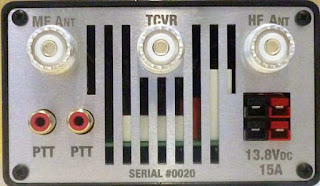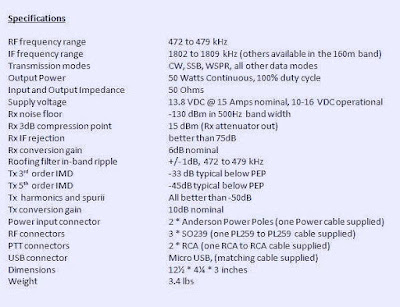 The New VK4YB 630m Transverter
The New VK4YB 630m Transverter
For the past several months I have been beaconing overnight on 630m WSPR mode. I've been using a new transverter designed by Roger Croft (VK4YB) and Ralph Loveday, in Queensland, Australia. One unit was sent to me for beta testing and I have been hammering it as hard as I can ever since setting it up in the spring ... no problems have been experienced after several months of 12 hour nightly beaconing punishment. Nightly signal reports often range from Hawaii / Alaska and eastward to New England ... all during the 'not so good' summer band conditions.
Now that beta testing is complete, production units are now ready for distribution from Monitor Sensors, a family environmental-sensor manufacturing company of which Roger is Governing Director.
The introduction of the VK4YB 630m Transverter presents another new option for those wishing to get on the band, or in the case of American amateurs, to get prepared for the band ... soon expected to be implemented in the U.S.
When I first started using the test unit provided, I was immediately impressed with how simple it was to set up and to get operational. It sits inconspicuously beside the main station's transceiver, taking up less space than the typical station speaker unit.
One usually associates 'transverter' operation with a rat's-nest of cabling or re-cabling to accommodate the new addition. The transverter arrived with all necessary cabling, even a nice Anderson power pole connector to connect the user-supplied 12V power source. A second pair of 12V contacts is also available for sharing with other station needs. One feature that I quickly appreciated was the dual RCA jack on the rear panel for controlling the transverter's PTT keying line. With my transceiver's PTT line already being used for another purpose, it was simply a matter of plugging-in (cable supplied) and sharing the line with the second jack ... no need for unplugging or using an external adapter to split the PTT line. Switching from 630m to normal HF operation is simply a matter of turning the transverter 'off' ... all HF operations are back to normal with antenna routing taken care of. There appears to be a lot of thoughtful engineering packed into this little box.
A look under the hood shows a well-planned and efficient use of space as seen in this pre-production prototype shown below. If Collins Radio were to manufacture a 630m transverter for the military, I can't imagine it being any better than this!
 |
| prototype board under test |
"... we carefully match the FETs into three pairs. Each pair is matched to its opposite number but the pairs are chosen so 2 have low gain, 2 have mid gain and 2 have high gain. This improves the IPs and also the harmonics. With matched FETs we are getting the 2nd harmonic at typically -60dB. That's 10dB better than the stringent FCC requirement."
Roger's unit is running at 16 volts and produces 90W output, with his 630m WSPR signal being the one most often heard in North America from down under.
The transverter's multi-colored screen combines with a multi-function menu, allowing a visual on-screen display of numerous parameters such as RF output power, DC supply voltage and current draw, SWR, exciter drive power, heatsink temperature, graphic SWR display and various warning screens.
The transverter requires 3-5 watts of 160m drive from the station transceiver for full output power. Built-in safety circuits prevent overdrive from causing any damage. Similarly, transmitting into a high SWR or with no antenna connected is no cause for concern. Temperature sensors will trigger shutdown should the heatsink rise above 100 degrees C. Software also prevents out-of-band transmission.
This is a microprocessor controlled linear-transverter. This means that operating system software can be readily updated (via the supplied micro USB cable) as new features are implemented. It also means that any mode your transceiver is capable of operating on can be produced on 630m. At present, the most popular modes on the band are WSPR, CW and JT9 but I suspect this order may change once the band is opened up in the U.S.
A shortened eight-page Operator's Manual can be downloaded from the Monitor Sensors web site but units will ship with a more comprehensive 22-page manual. For more information regarding pricing and shipping, please contact Monitor Sensors here. For technical questions, please contact Roger here.

















looking for a RX to copy NDB
Grab a used Icom R-75 if you can James. It’s a superb performer on the BCB and below.
What is your antenna and match?
Ian
Ian, I use an inverted-L with a base loading to resonate and match with a ferrite transformer (several taps)
I’m thinking of grabbing one of these to take on DXpedition to Costa Rica in October. Looks like a fun idea.
I have been using this transverter for about a month, and it is an outstanding product. Over three weekends I have worked 15 states, including Hawaii from Colorado. Most of the states have been worked more than once, plus the Cayman Islands. The front end on receive eliminates the very strong AM broadcast signals that are normally a problem with many transceivers when connected to my 160m antenna. I only needed a new tuner for 630m to get on the air, reusing my 160m Marconi T antenna. I work mostly JT9, but some CW and the WSPR stations come in every day once it starts getting dark. Semi-break-in with my IC-7300 and transverter work great. I have copied VK4YB on both WSPR and JT9 many times, usually each weekend, but I’ll need more power to make a QSO with Roger in Australia.